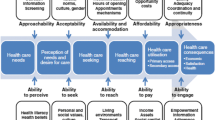Abstract
OBJECTIVE: To determine whether patients who encountered language barriers during an emergency department visit were less likely to be referred for a follow-up appointment and less likely to complete a recommended appointment.
DESIGN: Cohort study.
SETTING: Public hospital emergency department.
PARTICIPANTS: English- and Spanish-speaking patients (N=714) presenting with nonemergent medical problems.
MEASUREMENTS AND MAIN RESULTS: Patients were interviewed to determine sociodemographic information, health status, whether an interpreter was used, and whether an interpreter should have been used. The dependent variables were referral for a follow-up appointment after the emergency department visit and appointment compliance, as determined by chart review and the hospital information system. The proportion of patients who received a follow-up appointment was 83% for those without language barriers, 75% for those who communicated through an interpreter, and 76% for those who said an interpreter should have been used but was not (P=.05). In multivariate analysis, the adjusted odds ratio for not receiving a follow-up appointment was 1.92 (95% confidence interval [CI], 1.11 to 3.33) for patients who had an interpreter and 1.79 (95% CI, 1.00 to 3.23) for patients who said an interpreter should have been used (compared with patients without language barriers). Appointment compliance rates were similar for patients who communicated through an interpreter, those who said an interpreter should have been used but was not, and those without language barriers (60%, 54%, and 64%, respectively; P=.78).
CONCLUSIONS: Language barriers may decrease the likelihood that a patient is given a follow-up appointment after an emergency department visit. However, patients who experienced language barriers were equally likely to comply with follow-up appointments.
Similar content being viewed by others
References
Treviño FM, Moyer ME, Valdex RB, Stroup-Benham CA. Health insurance coverage and utilization of health services by Mexican American, mainland Puerto Ricans, and Cuban Americans. JAMA. 1991;265:233–7.
Hough RL, Landsverk JA, Karno M, et al. Utilization of health and mental services by Los Angeles Mexican Americans and non-Hispanic whites. Arch Gen Psychiatry. 1987;44:702–9.
Valdez RB, Morgenstern H, Brown ER, Wyn R, Wang C, Cumberland W. Insuring Latinos against the cost of illness. JAMA. 1993;269:889–94.
Andersen R, Lewis SZ, Giachello AL, Aday LA, Chiu G. Access to medical care among the Hispanic population of the Southwestern United States. J Health Soc Behav. 1981;22:78–89.
Gany F, De Bocanegra HT. Overcoming barriers to improving the health of immigrant women. J Am Med Womens Assoc. 1996;51:155–60.
Valdez RB, Giachello AL, Rodriquez-Trias H, Gomez P, De la Rocha C. Improving access to health care in Latino communities. Public Health Rep. 1993;108:534–9.
Andersen R, Giachello AL, Aday LA. Access of Hispanics to health care and cuts in services: a state-of-the-art overview. Public Health Rep. 1986;101:238–52.
Pitkin K, Baker DW. Limited English proficiency and Latinos’ use of physician services. Med Care Res Rev. In press.
Schur CL, Albers LA, Berk ML. Health care use by Hispanic adults: financial vs. non-financial determinants. Health Care Financing Rev. 1995;17:71–88.
Baker DW, Hayes R, Puebla-Fortier J. Interpreter use and satisfaction with interpersonal aspects of care for Spanish-speaking patients. Med Care. 1998;36:1461–70.
Carrasquillo O, Orav EJ, Brennan TA, Burstin HR. Impact of language barriers on patient satisfaction in an emergency department. J Gen Intern Med. 1999;14:82–7.
Todd KH, Samaroo N, Hoffman JR. Ethnicity as a risk factor for inadequate emergency department analgesia. JAMA. 1993;269:1537–9.
Manson A. Language concordance as a determinant of patient compliance and emergency room use in patients with asthma. Med Care. 1988;26:1119–28.
Parker RM, Baker DW, Williams MV, Nurss JR. The Test of Functional Health Literacy in Adults (TOFHLA): a new instrument for measuring patients’ literacy skills. J Gen Intern Med. 1995;10:537–41.
Magnusson AR, Hedges JR, Vanko M, McCarten K, Moorhead JC. Follow-up compliance after emergency department evaluation. Ann Emerg Med. 1992;22:560–7.
Todd KH, Lee T, Hoffman JR. The effect of ethnicity on physician estimates of pain severity in patients with isolated extremity trauma. JAMA. 1994;274:925–8.
Cleeland CS, Gonin R, Baez L, Loehrer P, Pandya KJ. Pain and treatment of pain in minority patients with cancer: The Eastern Cooperative Oncology Group Minority Outpatient Pain Study. Ann Intern Med. 1997;127:813–6.
Ziv TA, Lo B. Denial of care to illegal immigrants: Proposition 187 in California. N Engl J Med. 1995;332:1095–8.
Author information
Authors and Affiliations
Corresponding author
Rights and permissions
About this article
Cite this article
Sarver, J., Baker, D.W. Effect of language barriers on follow-up appointments after an emergency department visit. J GEN INTERN MED 15, 256–264 (2000). https://doi.org/10.1111/j.1525-1497.2000.06469.x
Issue Date:
DOI: https://doi.org/10.1111/j.1525-1497.2000.06469.x




